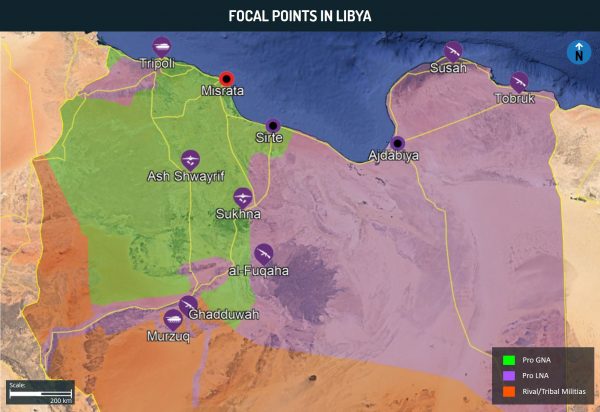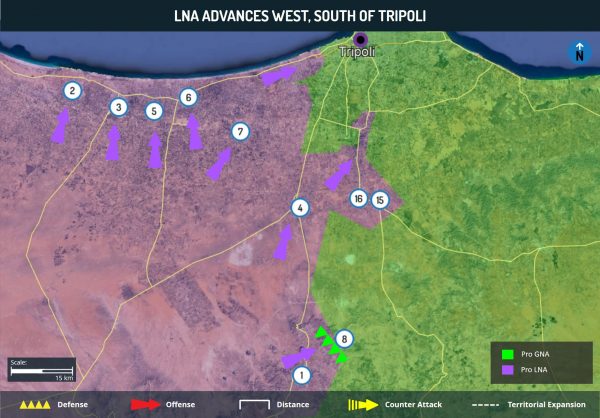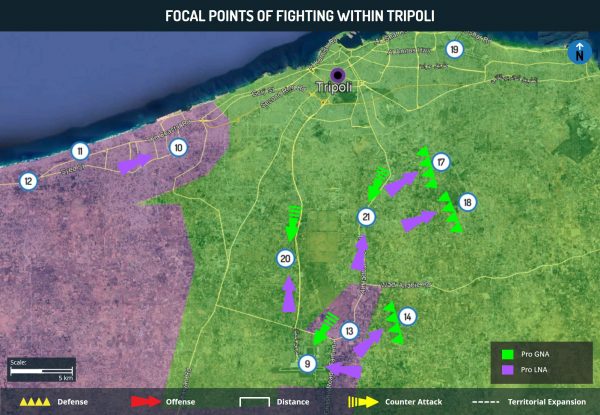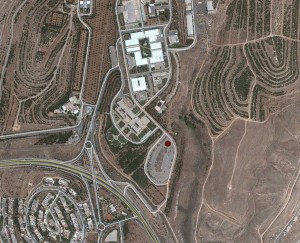Executive Summary
The latest hostilities in Tripoli come within the context of the Libyan National Army’s (LNA) Operation “Flood of Dignity”, aimed at eliminating local militias operating within the capital, and the Government of National Accord’s (GNA) counter-offensive, Operation “Volcano of Wrath”, aimed at preventing the LNA from taking control of the city and its surrounding areas.
Although, the LNA managed to swiftly take control of several areas west and south of Tripoli within the first three days of the launch of Operation “Flood of Dignity”, the unification of militias within Tripoli under the umbrella of the Tripoli Protection Force (TPF) will present the LNA with challenges in making further territorial advances within the capital.
The April 8-9 Islamic State (IS)-perpetrated attack in al-Fuqaha bolsters our previous assessment regarding the potential increase in threat of militancy in the country over the coming weeks and months, as militant group’s attempt to take advantage of the LNA and GNA-linked forces’ preoccupation in hostilities in northwestern Libya to ramp up their operations within the country, without the threat of being detected by security forces.
Overall, the security situation in Libya is likely to significantly deteriorate over the coming weeks and months. As the LNA’s Operation “Flood of Dignity” becomes protracted, as a result of strong defensive measures adopted by GNA-linked forces, it will be compelled to divert further troops from other parts of Libya towards Tripoli. This will allow IS to regroup in eastern and southern parts of Libya and increase the frequency of its operations over the coming weeks.
Current Situation
Across the country, the following incidents have been reported:
Fezzan Region
| Date | District/City | Brief Description |
| March 28 | Ghadduwah | Islamic State (IS) claims killing of two Libyan “agents” and kidnapping of others in an attack. |
| April 2 | Sebha | Reports indicate that “heavy machine gunfire” was heard in downtown Sebha. |
| April 8 | Murzuq | Government of National Accord (GNA)-linked forces reportedly seize control of the Murzuq checkpoint from Libyan National Army (LNA) forces. |
Misrata Environs
| Date | District/City | Brief Description |
| April 1 | Bani Walid | A GNA team representing Libya’s Airports Authority inspected the Bani Walid Airport to reportedly prepare it to receive civil flights. |
Jufra District
| Date | District/City | Brief Description |
| April 8-9 | al-Fuqaha | IS militants reportedly entered the town of al-Fuqaha during the overnight hours of April 8-9 in 13-15 vehicles and cut off all communications to it. The militants also executed the head of the local council and of the municipal guard as well as burned down houses. |
| April 9 | Sukhna | GNA aircraft from Misrata reportedly conduct airstrikes against LNA positions in Sukhna. The LNA accused the GNA aircraft of targeting a civilian farm. |
Sirte Basin
| Date | District/City | Brief Description |
| April 1 | Sirte | Reports indicate that Sirte’s Gaddhafi tribe is demanding the departure of the Sirte Protection Force following the reported killing of a member of the tribe by the latter. |
| April 1 | Gate 50, east of Sirte | GNA-linked forces reportedly reached “Gate 50” from Sultan, establishing a checkpoint in the area. |
Tobruk Environs
| Date | District/City | Brief Description |
| April 8 | Susah, Tobruk | The LNA reportedly discovered and dismantled IEDs in a vehicle in Tobruk. In Susah’s Sunday market, LNA forces dismantled an adhesive bomb on a car. |
Tripoli Environs
| Map # | Date | District/City | Brief Description |
| March 30 | Western Region | LNA Field Marshal Khalifa Hafar appoints Abdulsalam al-Hassi as commander of the LNA’s Western Region Operations Room. | |
| March 31 | Tripoli | The LNA confirms its readiness to enter Tripoli to eliminate militias and other armed groups. | |
| April 1 | Tripoli | The Tripoli Protection Force (TPF) issues a statement confirming its participation in a meeting regarding the unification of armed forces in the region. | |
| April 3 | Tripoli | The UN-backed Government of National Accord (GNA) releases a communique denouncing the latest advancements by the LNA in areas south of Tripoli, stating that the government has ordered the general mobilization of all military, security, and police forces to prepare for a response to any attack on the capital. | |
| 1 | April 4 | Gharyan | LNA Spokesperson Colonel Ahmed Mismari confirms the peaceful entrance of the LNA into Gharyan. LNA Commander of Western Region Operation Room, Abdulsalam al-Hassi announced that the LNA is in control of Gharyan. |
| April 4 | Tripoli | Secretary General of the UN, Antonio Guterres, denounced the current instability in a visit to Tripoli. | |
| April 4 | Tripoli | Haftar announces the beginning of Operation “Flood of Dignity” to “liberate” Tripoli from the control of armed militias. | |
| 2, 3, 4, 5, 6, 7 | April 4 | Sabratha, Surman, al-Aziziya, As Sabiriya, Zawiya, al-Zahra area | LNA captures the towns of Surman, al-Aziziya, As Sabria, Zawiya, and the al-Zahra area from GNA-linked militias. |
| 8 | April 4 | Wadi al-Hira | The LNA announces that its forces clashed with forces led by the GNA-appointed commander of the Western Military Region, Usama al-Juweili, in Wadi al-Hira. |
| 9 | April 4 | Tripoli International Airport | LNA declares control over non-operational Tripoli International Airport. |
| 10 | April 4 | Janzour neighborhood, Tripoli | LNA forces take control of western Tripoli’s Janzour neighborhood. |
| 11 | April 4-5 | Sidi Bilal Naval Base | The LNA landed several of its naval vessels at the Sidi Bilal Naval Base, located just west of Tripoli’s Janzour neighborhood, during the overnight hours of April 4-5. |
| April 4-5 | Tripoli | The Tripoli Protection Force (TPF) announces the launch of the second phase of Operation “Wadi al-Dom” against LNA forces during the overnight hours of April 4-5. | |
| 12 | April 4-5 | Gate 27, western entrance to Tripoli | The TPF launched a counter-offensive against the LNA and was able to take back control of Gate 27, located at the western entrance to Tripoli. Gate 27 had been temporarily captured by LNA forces during the night hours of April 4. |
| 13, 14, 15 | April 5 | Qasr Bin Ghashir, Wadi al-Rabee and Souq al-Khamis; Tripoli | LNA seizes control of territory in Tripoli’s Qasr Bin Ghashir, Wadi al-Rabee, and Souq al-Khamis districts. |
| April 6 | Western Libya | Libyan Air Force (LAF) declares western Libya a “no–fly zone” and indicates that any military aircraft including those “conducting aerial photography” but “excluding commercial flights” identified in the area will be considered as a “hostile target”. The LNA added that the aircraft’s point of departure will also be deemed a legitimate target. | |
| 16, 17, 18 | April 6 | Sadiya, Ain Zara, Khallet al-Furjan; Tripoli | LNA makes multiple territorial gains in Tripoli’s Sadiya, Ain Zara, and Khallet al-Furjan districts. |
| April 6 | Wadi al-Rabee, Souq al-Khamis; Tripoli | GNA conducts airstrikes against LNA positions in Tripoli’s Wadi al-Rabee and Souq al-Khamis districts. | |
| April 6 | al-Aziziyah, Gharyan | GNA conducts airstrikes against LNA positions in al-Aziziyah and Gharyan. | |
| April 7 | Tripoli | GNA announces launch of anti-LNA Operation “Volcano of Wrath”. | |
| April 7 | Tripoli | US Africa Command (AFRICOM) issues statement announcing the temporary relocation of a contingent of US troops supporting US AFRICOM due to the “security conditions on the ground”. | |
| 19 | April 8 | Mitiga International Airport | LAF conducts airstrikes targeting the Mitiga International Airport. |
| April 8 | Tripoli International Airport | GNA-linked militias reportedly take back control of the Tripoli International Airport from the LNA. | |
| 20 | April 8 | Yarmouk Refugee Camp | 29 LNA soldiers surrender to GNA-linked forces in the Yarmouk Refugee Camp. |
| April 8 | Tripoli | Italy begins to evacuate its troops from Tripoli. | |
| April 8-9 | Tripoli | UN Special Mission in Libya (UNSMIL) evacuates its staff from Tripoli. | |
| April 8 | Tripoli | GNA announces the closure of the air space over Tripoli. Misrata forces reportedly deploy air defense systems in the capital. | |
| 21 | April 9 | Salah al-Din District | GNA-linked forces take control of several areas in Salah al-Din District after the withdrawal of LNA forces. |
| April 9 | Warshefana District | LAF conducts airstrikes against GNA positions. | |
| April 9 | Tripoli International Airport | LAF conducts airstrikes against the GNA-held Tripoli International Airport. | |
| April 9 | Ash Shwayrif | LAF conducts airstrikes against fuel trucks in Ash Shwayrif. The trucks were reportedly en route to the LNA-held Gharyan. |
Political Developments
| Date | Brief Description |
| March 30 | Libya held municipal elections in nine municipalities, which had a turnout of 40 percent of registered voters. |
| March 31 | GNA Prime Minister Fayez al-Serraj called on Arab countries to agree on Libyan crisis during 30th Arab summit in Tunis. |
| March 31 | A bilateral cooperation agreement was signed between the Atomic Energy Cooperation and The Libyan Center for Remote Sensing and Space Sciences. |
| April 2 | Reports indicated that trade between Libya and Algeria has faced hurdles over the past days in light of the continued closure of the border between the two countries. |
Assessments & Forecast
The latest developments in Tripoli come within the context of the LNA’s Operation “Flood of Dignity”, which is aimed at eliminating local militias operating within the capital, and the GNA’s counter-offensive, named Operation “Volcano of Wrath”, which is aimed at preventing the LNA from taking control of the city and its surrounding areas. The fact that the LNA managed to swiftly take control of several areas located west and south of the capital within a short span of time can be attributed to two main factors. First, the LNA had the advantage of surprise during the initial days of Operation “Flood of Dignity”. This allowed LNA forces to advance swiftly and take control of areas, such as Gharyan, Aziziyah, Surman, and Zawiya, without much resistance. This is particularly as this lack of time prevented the local militias who were in control of these towns to form any significant alliances to present a unified defense. Second, the local militias that were in control of the aforementioned towns are largely self-trained and lack the necessary resources required to withstand an offensive by the relatively better equipped and trained LNA troops. The LNA’s recent territorial gains against local militias in southern Libya likely prompted militias in northwestern Libya to concede territory to advancing LNA forces, in an effort to preserve the lives of their fighters and their respective cities’ infrastructure.
FORECAST: That said, while the LNA managed to make significant territorial gains within the first three days of the launch of Operation “Flood of Dignity” is not indicative of a similar positive momentum for LNA forces in the future. Areas within Tripoli are controlled by militias, such as the al-Radaa Deterrence Forces, the Tripoli Revolutionaries’ Brigade, and the Abu Salim Unit, which are unified under the umbrella organization of the Tripoli Protection Force (TPF). This will allow the TPF to present a stronger defense to advancing LNA forces, as already underlined by the fact that GNA-linked forces managed to reverse almost all the gains made by the LNA in the Qasr Bin Ghashir, Ain Zara, Salah al-Din, and Wadi al-Rabee districts on April 8-9. Moreover, recent reinforcements diverted by Misrata forces from Misrata towards Tripoli will allow the GNA to bolster its defenses within downtown Tripoli, further slowing down the LNA’s advances into the capital. Although, the LNA is likely to employ the use of heavy weaponry, such as tanks, mortar shelling, and airstrikes as cover for its ground troops, its forces are likely to refrain from making indiscriminate use of such a strategy as it will inevitably result in civilian collateral damage. A high civilian casualty count has the potential to significantly diminish Haftar’s increased international and national legitimacy.
The IS-perpetrated attack in al-Fuqaha bolsters our previous assessment that Sunni jihadist militant groups operating in Libya will likely attempt to take advantage of the LNA and the GNA-linked forces’ preoccupation in fighting each other in northwestern Libya to conduct attacks and potentially attempt to take control of territory in other parts of the country. IS has conducted several attacks in the al-Fuqaha area in the past, with the most notable one occurring during the overnight hours of October 28-29, 2018. The Sunni jihadist militant group’s known operational presence in the areas surrounding al-Fuqaha likely allowed it to quickly mobilize its fighters in the aftermath of the outbreak of hostilities near Tripoli and launch the latest attack. This is supported by the relatively low-scale of the attack, which indicates that it was likely planned and executed within a short span of time. FORECAST: The LNA will likely divert at least some troops and resources towards al-Fuqaha over the coming days in order to secure the town. These troops will likely be diverted from fronts other than Tripoli, in an effort to prevent the down-scaling of Operation “Flood of Dignity”. However, such a scenario is liable to leave other parts of eastern and southern Libya vulnerable to IS operations. Overall, the Sunni jihadist militant group will attempt to increase the frequency, symbolism, and scale of its attacks in Libya over the coming days and weeks.
Recommendations
It is advised to defer all travel to Tripoli and Benghazi at this time due to a recent uptick in violence, threats against foreigners, and the risk of a broad deterioration of security conditions. We advise at this time that those remaining in Tripoli and Benghazi should initiate contingency and emergency evacuation plans due to deterioration in the security situation. Contact us at [email protected] or +44 20-3540-0434 for itinerary and contingency support plans.
For those remaining in Tripoli, we advise to avoid nonessential travel to the outskirts of the city, particularly the Janzour and Tajoura neighborhoods, as well as to the Mitiga and Tripoli International Airports, given that these are the focal points of ground clashes and airstrikes in the city.
Travel to Misrata and Tobruk should be for essential purposes only, while adhering to all security precautions regarding civil unrest and militancy. We advise against all travel to outlying areas of the country, due to the threat of militancy, kidnapping, and general lawlessness in such areas.
Avoid entering Libyan territorial waters in the area between Benghazi and al-Tamimi without prior authorization, as a “no-sail zone” is currently in effect in this area and several naval vessels had been intercepted or attacked due to not following proper procedures.
Those planning to conduct air travel to, from and inside Libya should avoid entering the area between Marsa al-Brega, Sirte and Sebha, as it was declared a no-fly zone by the Libyan National Army (LNA).
We further advise against all travel to Libya’s border areas at this time due to persistent violence and lawlessness in these regions.



